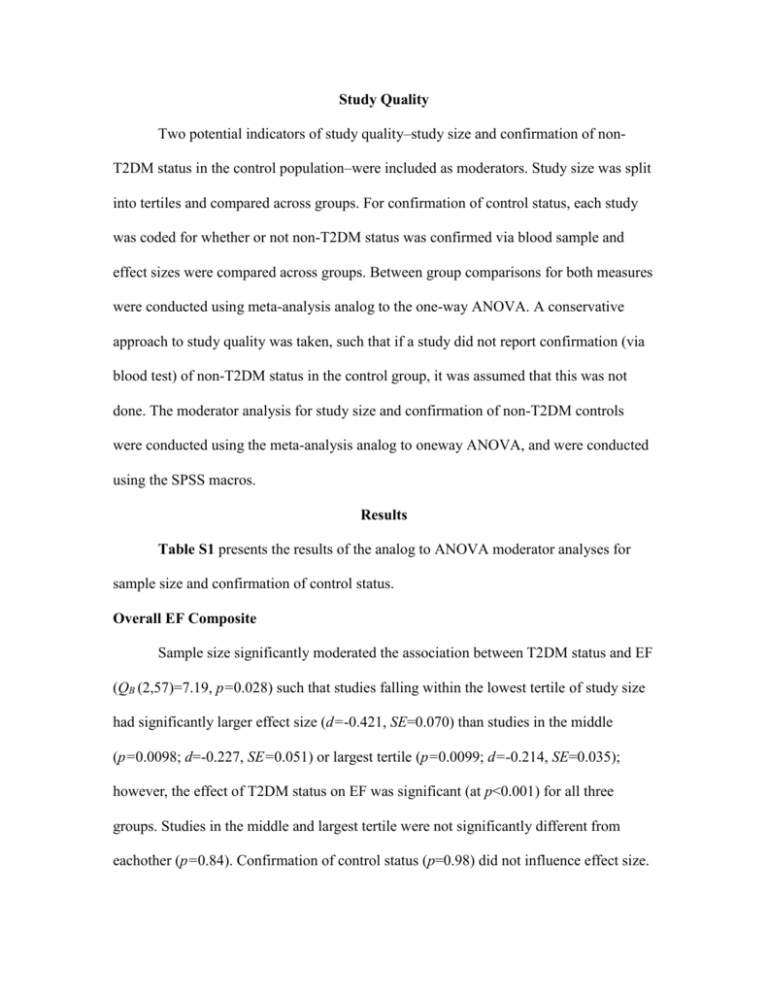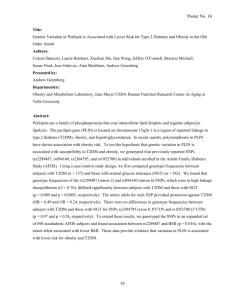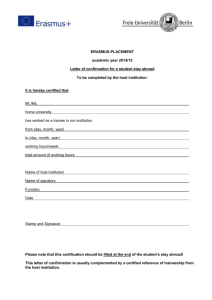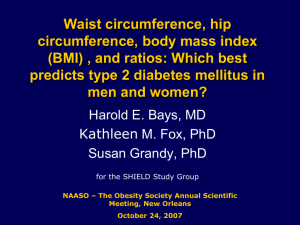Q B (df)
advertisement

Study Quality Two potential indicators of study quality–study size and confirmation of nonT2DM status in the control population–were included as moderators. Study size was split into tertiles and compared across groups. For confirmation of control status, each study was coded for whether or not non-T2DM status was confirmed via blood sample and effect sizes were compared across groups. Between group comparisons for both measures were conducted using meta-analysis analog to the one-way ANOVA. A conservative approach to study quality was taken, such that if a study did not report confirmation (via blood test) of non-T2DM status in the control group, it was assumed that this was not done. The moderator analysis for study size and confirmation of non-T2DM controls were conducted using the meta-analysis analog to oneway ANOVA, and were conducted using the SPSS macros. Results Table S1 presents the results of the analog to ANOVA moderator analyses for sample size and confirmation of control status. Overall EF Composite Sample size significantly moderated the association between T2DM status and EF (QB (2,57)=7.19, p=0.028) such that studies falling within the lowest tertile of study size had significantly larger effect size (d=-0.421, SE=0.070) than studies in the middle (p=0.0098; d=-0.227, SE=0.051) or largest tertile (p=0.0099; d=-0.214, SE=0.035); however, the effect of T2DM status on EF was significant (at p<0.001) for all three groups. Studies in the middle and largest tertile were not significantly different from eachother (p=0.84). Confirmation of control status (p=0.98) did not influence effect size. Verbal Fluency Sample size also significantly moderated the association between T2DM status and EF (QB (2,28)=23.30, p<0.001) such that studies falling within the lowest tertile of study size had significantly larger effect size (d=-0.545, SE=0.088) than studies in the middle (p=0.0035; d=-0.237, SE=0.059) or largest tertile (p<0.001; d=-0.143, SE=0.019); however the effect of T2DM status on EF was significant (at p<0.001) for all three groups. Studies in the middle and largest tertile were not significantly different from each other (p=0.10). Confirmation of control status (p=0.51) did not moderate the association between T2DM and EF Mental Flexibility Neither confirmation of control status (p=0.63), nor sample size (p=0.45) moderated the association between T2DM and EF. Working Memory Neither confirmation of control status (p=0.76), nor sample size (p=0.12) moderated the association between T2DM and EF. Attention Neither confirmation of T2DM status (p=0.28), nor sample size (p=0.16) moderated the association between T2DM and EF. Discussion With respect to study quality, moderator analysis revealed a significant effect of sample size for both the overall EF composite and the verbal fluency subcomponent, such that studies in the smallest tertile of sample size had larger effect sizes than those in the middle or largest tertiles; however, sample size did not moderate the size of the effect for mental flexibility, working memory, or attention. Importantly, while study size significantly moderated the effect size of the association between T2DM and lower EF, the association was statistically significant for all three tertiles. Study sample size is often used an indicator of study quality; however, it is important to recognize that other factors affecting study quality may be of equal importance particularly within the context of the association between T2DM and EF. For example, matching on relevant characteristics such as age, sex, and education, as well as, exclusion of potentially confounding disorders such as hypertension, cerebrovascular disease or other cognitive disorders are all relevant to the relationship between T2DM and EF and may have played a role in differences in effect sizes observed. Additionally, it is possible that these methods may have been employed disproportionately in small-to-moderate sized studies for logistical reasons. Interestingly, confirmation of non-T2DM control status did not moderate effect size. This may indicate that self-report methods of ascertaining T2DM status are sufficient for assessing the relationship between T2DM and EF; however, it is also possible that between study differences on other important factors (such as those listed above) may have confounded a potential moderating effect of confirmation of non-T2DM control status. Table S1: Moderator Analysis – Analog to ANOVA Moderator Sample Size Control Status n 79069 79069 k QB(df) Overall EF 60 7.19 (2) 60 0.0007(1) p QW(df) p 0.028 0.98 53.93 (57) 58.00(58) 0.59 0.48 25.23 (28) 37.38 (29) 0.62 0.14 20.92 (19) 20.49 (20) 0.34 0.43 29.88 (25) 32.69 (26) 0.23 0.17 34.82 (24) 34.76 (25) 0.071 0.093 Sample Size Control Status 41467 41467 Sample Size Control Status 24243 24243 Verbal Fluency 31 23.30 (2) <0.001 31 0.44 (1) 0.51 Mental Flexibility 22 1.58 (2) 0.45 22 0.23 (1) 0.63 Sample Size Control Status 28118 28118 Working Memory 28 4.30 (2) 0.12 28 0.09 (1) 0.76 Sample Size Control Status 25669 25669 27 27 Attention 3.62 (2) 1.17 (1) 0.16 0.28











